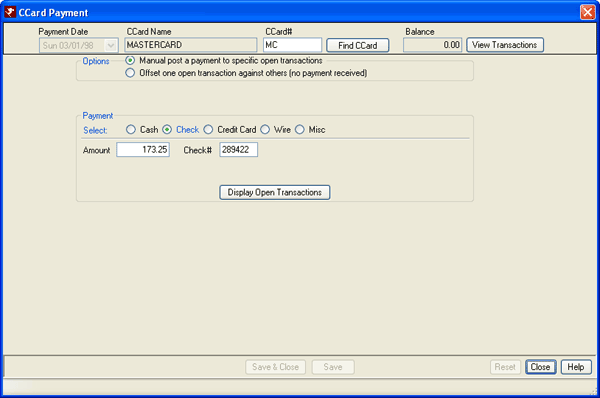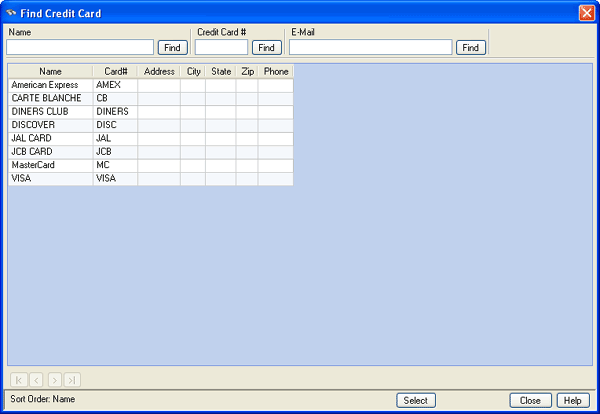Click here for Master Tutorials
Click here for Credit Card Navigation
|
Credit Card Master Functions |
|
|---|---|
| Add |
Payments |
Steps
There are many steps and pieces of information that can be filed on the payment transaction record. The steps below should be used as an example and vary greatly for every property using RDPWin.
- Access Find from the Masters | Credit Card submenu and select a card master.
- Click the Payment link in Navigation.
- Select from the payment options: (1) Manual post a payment to specific open transactions, or (2) Offset one open transaction against others (no payment received).
- When "Manual post..." is selected, the Payment Type must be selected too.
- Enter the Amount. (Payment by check requires a check number, by credit card requires account information, and miscellaneous payments require a description.)
- Save & Close.
Credit Card Payments
When credit card companies credit the property with a payment, record the activity using Payments. Select from the auto-post, manual post, or offset a single transaction methods. However, autopay is required when using Balance Forward statements and manual pay for Open Item statements. 
- Payment Date
- The current RDP system date is the default setting and cannot be changed for credit card masters.
- Balance
- A positive number in this field represents monies owed to the property, and a negative number represents monies owed to the credit card. This number matches the Running Balance on the Credit Card Transaction tab.
- View Transactions
- Click to open the Transaction tab and view transactions for the selected credit card master.
- Autopost a Payment to the Oldest Open Transactions
- Apply the payment amount against the entire balance due as opposed to a manual payment where the amount is applied to individual open charges. Autopost should only be used with balance forward credit card masters. Customers using open item statements should never use auto-post. The payment is allocated toward the total balance due, reducing the credit card receivable.
- Manually Post a Payment to Specific Open Transactions
- Apply the payment amount against individual open charges as opposed to a auto-post payments where the amount is applied to the entire balance due. Manual post must be used with open item statements. Select the Type of payment to be processed and click the Display Open Transactions button to select the specific transaction to which the payment is to post.
- Offset One Open Transaction Against Others (No Payment Received)
- The offset option is used with open item statements to offset one open transaction against others without receiving a payment. For example, assume $1,000 is received. Two weeks later, a $1,000 credit is required. Both of these transactions would show on the open item statement. The first payment shows in the Unallocated Payment section. The offset mode is used to apply one transaction against another, thus removing both transactions from the open item statement. The offset mode should never be used with balance forward statements.
- Payment Type
- The Amount defaults to the full balance due. Select the payment type: credit card, cash, check, misc, or wire. Complete the details (differ based on payment type). When complete, Click Save & Close to process and save the payment.
Take Payments from Multiple Credit Card Masters
- Find CCard
- When the Payment screen is open, use the Find CCard button to
select an credit card master and take a payment. Once complete, use the Find
CCard button to select another credit card master and take a payment. This
process allows for taking payments from multiple credit card masters without closing
the Payment screen.

Save & Close, Save, Reset, and Close
It is only necessary to save changes before switching tabs when in configuration. Otherwise, change any or all tabs within Masters and save only once; however, saving at anytime is available. The Save & Close button saves the changes and closes the form. The Save button files changes and keeps the form open. Reset restores the settings to those most recently saved and abandons any unsaved changes. Close prompts before exiting without saving changed settings (if any were made) and closes the form.
Click these links for Frequently Asked Questions or Troubleshooting assistance.
05/20/2010
© 1983-2009 Resort Data Processing Inc. All rights reserved.